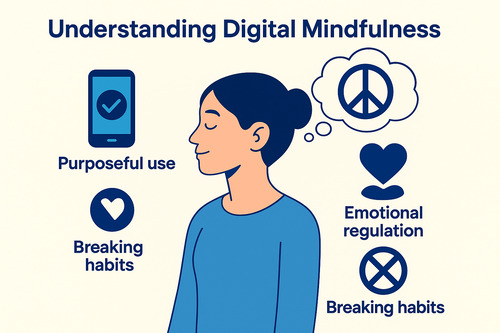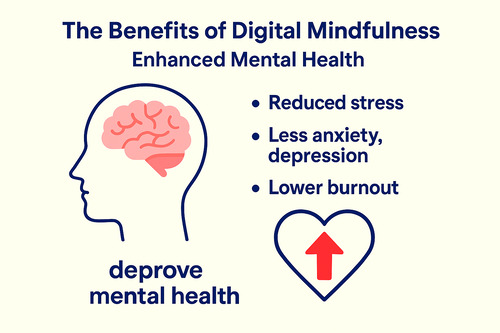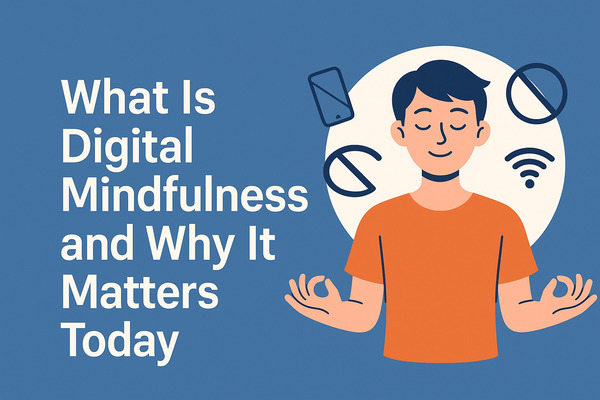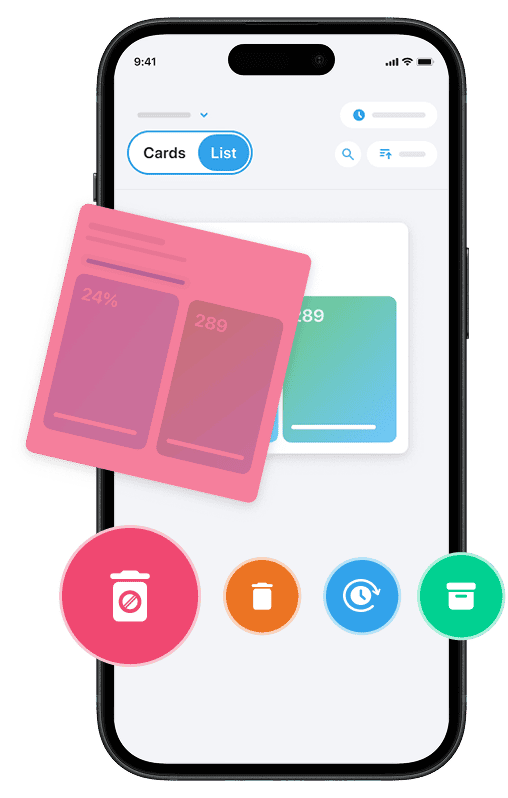In today’s fast-paced and digitally connected world, digital mindfulness has become a valuable tool for supporting mental health and well-being. It involves the use of apps, mobile platforms, or online resources to deliver mindfulness training and meditation in easily accessible digital formats.
These programs aim to reduce stress, anxiety, depression, and burnout, offering a scalable solution for diverse groups such as students, healthcare professionals, and employees. Supported by numerous randomized controlled trials and systematic reviews, digital mindfulness often incorporates elements of compassion and intentional focus to foster emotional balance and resilience.
As research expands, including meta-analyses and cluster randomized trials, evidence highlights the effectiveness of these tools in enhancing mental well-being. By integrating mindfulness into flexible session formats that fit modern lifestyles, digital mindfulness offers accessible, low-cost, and scientifically backed ways to improve quality of life.
And digital mindfulness isn’t just about meditation apps — it can also mean simplifying your digital environment. A clutter-free inbox helps reduce stress and distraction. With Cleanfox, you can easily clear spam and unwanted emails, bringing more focus and calm into your day — completely free. You can also adopt healthy email routines that reinforce digital mindfulness and support long-term productivity.
Understanding Digital Mindfulness
Definition and Core Principles
Digital mindfulness is the intentional practice of being fully present and engaged while using digital devices and technologies. Unlike passive or distracted interactions, it encourages conscious awareness of how you consume content, communicate, and allocate your attention in the digital environment. The core principles focus on purposeful use, emotional regulation, and breaking habitual, reactive digital behaviors to foster a balanced relationship with technology.

This practice draws from traditional mindfulness teachings—emphasizing presence and non-judgmental observation—and applies these concepts to modern, screen-based experiences. By doing so, it helps you regain control of your attention amid constant digital stimuli. This intentional approach supports mental health by reducing digital overload and promoting authentic interactions online.
Techniques and Practices
Practicing digital mindfulness involves techniques such as setting specific time windows to check notifications instead of responding impulsively, performing “digital pauses” to reflect on your emotional state while online, and prioritizing quality over quantity in your digital engagements. Some people also benefit from structured resets, like a 10-day phone detox, which can help break unhealthy digital habits. Common methods include app-based mindfulness meditation sessions featuring mindful breathing, body scanning, and focused attention exercises to cultivate awareness during screen use.
Say goodbye to spam, clutter, and chaos.
Our smart email cleaner filters out junk, organizes your inbox, and helps you focus on what really matters.
✅ Block spam automatically
✅ Organize emails by priority
✅ Keep your inbox clean
✅ Clean old emails you don’t read
📱 Available on the App Store and Google Play.
Some interventions offer guided modules combining reading, experiential learning, journaling, and meditation, designed to be accessible via mobile apps for consistent practice. By training your mind in attentional control and emotional stability, these techniques help transform your digital interactions from overwhelming distractions into meaningful, purposeful experiences that support well-being and reduce stress.
The Benefits of Digital Mindfulness
Enhanced Mental Health
Digital mindfulness has been shown to significantly improve various aspects of mental health, including reductions in stress, anxiety, depression, and burnout. Studies involving randomized controlled trials consistently demonstrate that participants who engage in digital mindfulness practices experience sustained improvements in well-being and emotional regulation. For example, employees using app-based digital meditation reported decreased job strain and an enhanced ability to positively reappraise stressful situations, contributing to long-lasting mental health benefits.
These interventions enhance mindfulness and attention regulation, which in turn help individuals better cope with both general and work-related stress.

Evidence also suggests that digital mindfulness is particularly effective for university students and clinical populations, where short-duration, accessible sessions lead to improvements in perceived stress and anxiety levels. The ability of these digital interventions to scale and be tailored to individual needs increases their reach and utility in addressing the global mental health burden.
Boosted Productivity and Focus
Beyond mental health improvements, digital mindfulness also supports enhanced productivity and focus. By training attentional control and reducing cognitive distractions, these practices help users regain focus during their digital engagements.
Research in workplace settings reveals that even brief daily sessions of app-based mindfulness meditation can increase work engagement, job reward perception, and overall job enjoyment, all of which correlate with higher productivity and reduced burnout. This boost in focus results from improved emotional regulation and decreased mental fatigue, enabling clearer thinking and better task management in demanding environments.
Moreover, digital mindfulness practices foster self-compassion and mindful awareness, which further contribute to a more intentional and less reactive approach to digital interactions. These practices help you maintain concentration and reduce impulsivity throughout your day.
Implementing Digital Mindfulness in Daily Life
Personal Implementation
Incorporating digital mindfulness into your daily routine begins with intentional habits that promote balance and reduce digital overwhelm. Simple strategies include setting aside regular times for a digital detox, where you disconnect from all devices to create mental space and calm. To make these habits sustainable, it helps to build a foundation of digital life balance through intentional routines and healthier online behaviors.
Establishing clear boundaries is another key step. Limit notifications and schedule specific periods to check emails or social media. This prevents constant interruptions and helps you stay focused. Additionally, using free or mindful task management software to organize and prioritize your daily responsibilities can align your workflow with mindfulness goals, reducing stress and mental clutter.
Adopting mindful app usage is also essential. Evaluate and remove apps that do not support your well-being, creating a more intentional and positive digital environment. Over time, these practices help you develop self-awareness of your digital behaviors, enhance focus, and foster emotional resilience.
Professional and Educational Settings
In workplaces and educational environments, digital mindfulness can be implemented through brief, structured interventions designed to fit into busy schedules. Healthcare professionals benefit from app-based mindfulness programs with 5–10 minute sessions. These improve self-compassion and reduce mind-wandering.
Similarly, students engaging in online mindfulness therapy receive coaching through apps on mindful breathing, body scanning, and journaling. These practices help improve stress management and concentration. Organizations can further support mindful digital habits by encouraging designated workspaces, scheduled breaks, and mindful transitions between tasks.
Structured digital mindfulness builds intentionality and emotional support. This is vital in demanding professional and academic settings. By embracing these strategies, workplaces and schools can sustain productivity while reducing burnout.
Conclusion
Digital mindfulness provides an accessible and evidence-based solution to improve mental health by reducing stress, anxiety, and burnout. Through personalized, app-based interventions, it offers practical tools to enhance focus and build emotional resilience, making it invaluable both in personal and professional spheres.
Research shows digital mindfulness boosts balance and well-being. Begin with short sessions and mindful habits—your body and mind will benefit. The future of mental health support is digital, mindful, and entirely within your reach.
FAQ
What are the key benefits of practicing digital mindfulness in daily life?
Practicing digital mindfulness can significantly enhance your mental well-being by reducing depression and anxiety, improving focus, and encouraging healthier lifestyle choices like better sleep and regular exercise. It also helps lower stress levels, alleviates digital overwhelm, boosts productivity, and promotes a balanced work-life dynamic. By adopting intentional technology use, you can enjoy sustained mental health benefits.
How can digital mindfulness improve my focus and productivity when using technology?
Digital mindfulness reduces multitasking and distractions. It boosts focus and productivity by helping you engage with one task fully. This practice helps you enter a flow state, which boosts creativity and problem-solving skills. Additionally, it supports a better work-life balance by fostering intentional and present use of technology.
Using personalized mindfulness tools can further reinforce healthier digital habits.
What tools or strategies can help me implement digital mindfulness effectively?
To implement digital mindfulness effectively, you can use tools like task management software to organize and prioritize your work. Strategies such as regular digital detoxes, setting clear digital boundaries, mindful social media usage, and monitoring screen time are also highly beneficial. Meditation apps and online mindfulness courses can support you in developing a focused mindfulness practice. Additionally, reflecting on your digital habits and engaging in mindful content creation can deepen your mindfulness journey.
Why is digital mindfulness increasingly important for mental health in today’s digital age?
In today’s high-tech, high-stress world, digital mindfulness has become increasingly vital for mental health. It helps reduce stress, anxiety, depression, and burnout by fostering present-moment awareness and emotional regulation. Accessible and personalized digital platforms make it easier to integrate mindfulness into daily life, offering scalable and low-cost mental health support to sustain overall well-being.



